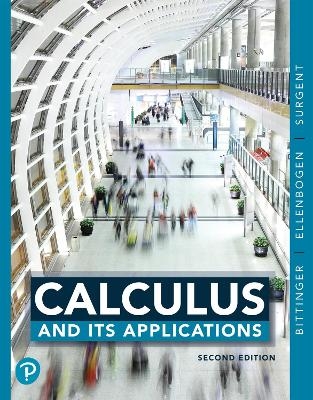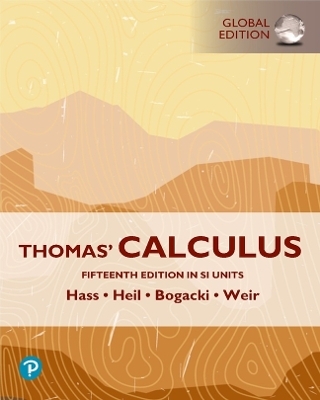
MyLab Math with Pearson eText Access Code for Calculus and Its Applications
Pearson (Hersteller)
978-0-13-521823-5 (ISBN)
- Titel z.Zt. nicht lieferbar
- Versandkostenfrei innerhalb Deutschlands
- Auch auf Rechnung
- Verfügbarkeit in der Filiale vor Ort prüfen
- Artikel merken
This item is an access card for MyLab™ Math. This physical access card includes an access code for your MyLab Math course. In order to access the online course you will also need a Course ID, provided by your instructor.
This title-specific access card provides access to the Bittinger/Ellenbogen/Surgent, Calculus and Its Applications, 2/e accompanying MyLab course ONLY.
0135218233 / 9780135218235 MYLAB MATH WITH PEARSON ETEXT -- STANDALONE ACCESS CARD -- FOR CALCULUS AND ITS APPLICATIONS, 2/e
MyLab Math is the world’s leading online tutorial, and assessment program designed to help you learn and succeed in your mathematics course. MyLab Math online courses are created to accompany one of Pearson’s best-selling math textbooks. Every MyLab Math course includes a complete, interactive eText. Learn more about MyLab Math.
ALERT:
Before you purchase, check with your instructor or review your course syllabus to ensure that you select the correct ISBN.
Used or rental books
If you rent or purchase a used book with an access code, the access code may have been redeemed previously and you may have to purchase a new access code.
Access codes
Access codes that are purchased from sellers other than Pearson carry a higher risk of being either the wrong ISBN or a previously redeemed code. Check with the seller prior to purchase.
About our authors Marvin Bittinger has been teaching math at the university level for more than 38 years. Since 1968, he has been employed at Indiana University - Purdue University Indianapolis, and is now professor emeritus of mathematics education. Professor Bittinger has authored over 250 publications on topics ranging from basic mathematics to algebra and trigonometry to applied calculus. He received his BA in mathematics from Manchester College and his PhD in mathematics education from Purdue University. Special honors include Distinguished Visiting Professor at the United States Air Force Academy and his election to the Manchester College Board of Trustees from 1992 to 1999. His hobbies include hiking in Utah, baseball, golf, and bowling. Professor Bittinger has also had the privilege of speaking at many mathematics conventions, most recently giving a lecture entitled "Baseball and Mathematics." In addition, he also has an interest in philosophy and theology, in particular, apologetics. Professor Bittinger currently lives in Carmel, Indiana with his wife Elaine. He has 2 grown and married sons, Lowell and Chris, and 4 granddaughters. David Ellenbogen has taught math at the college level for over 30 years, spending most of that time in the Massachusetts and Vermont community college systems, where he has served on both curriculum and developmental math committees. He has also taught at St. Michael's College and the University of Vermont. Professor Ellenbogen has been active in the American Mathematical Association of Two Year Colleges since 1985, having served on its Developmental Mathematics Committee and as a Vermont state delegate. He has been a member of the Mathematical Association of America since 1979, has authored dozens of publications on topics ranging from prealgebra to calculus, and has delivered lectures at numerous conferences on the use of language in mathematics. Professor Ellenbogen received his BA in mathematics from Bates College and his MA in community college mathematics education from the University of Massachusetts at Amherst, and a certificate of graduate study in Ecological Economics from the University of Vermont. Professor Ellenbogen has a deep love for the environment and the outdoors, and serves on the boards of 3 nonprofit organizations in his home state of Vermont. In his spare time, he enjoys playing jazz piano, hiking, biking, and skiing. He has 2 sons, Monroe and Zack. Scott Surgent received his B.S. and M.S. degrees in mathematics from the University of California - Riverside, and has taught mathematics at Arizona State University in Tempe, Arizona since 1994. He is an avid sports fan and has authored books on hockey, baseball, and hiking. Scott enjoys hiking and climbing the mountains of the western United States. He was active in search and rescue, including 6 years as an Emergency Medical Technician with the Central Arizona Mountain Rescue Association (Maricopa County Sheriff's Office) from 1998 until 2004. Scott and his wife Beth live in Scottsdale, Arizona. Gene Kramer received his PhD from the University of Cincinnati, where he researched the well-posedness of initial-boundary value problems for nonlinear wave equations. He is currently a professor of mathematics at the University of Cincinnati Blue Ash College. He is active in scholarship of teaching and learning research and is a member of the Academy of the Fellows for Teaching and Learning at the University of Cincinnati. He is a co-founder and an editor for The Journal for Research and Practice in College Teaching and serves as a Peer Reviewer for the Higher Learning Commission.
Prerequisite Skills Diagnostic Test
R. Functions, Graphs, and Models
R.1 Graphs and Equations
R.2 Functions and Models
R.3 Finding Domain and Range
R.4 Slope and Linear Functions
R.5 Nonlinear Functions and Models
R.6 Exponential and Logarithmic Functions
R.7 Mathematical Modeling and Curve Fitting
Chapter Summary
Chapter Review Exercises
Chapter Test
Extended Technology Application: Average Price of a Movie Ticket
1. Differentiation
1.1 Limits: A Numerical and Graphical Approach
1.2 Algebraic Limits and Continuity
1.3 Average Rates of Change
1.4 Differentiation Using Limits and Difference Quotients
1.5 Leibniz Notation and the Power and Sum–Difference Rules
1.6 The Product and Quotient Rules
1.7 The Chain Rule
1.8 Higher-Order Derivatives
Chapter Summary
Chapter Review Exercises
Chapter Test
Extended Technology Application: Path of a Baseball: The Tale of the Tape
2. Exponential and Logarithmic Functions
2.1 Exponential and Logarithmic Functions of the Natural Base, e
2.2 Derivatives of Exponential (Base-e) Functions
2.3 Derivatives of Natural Logarithmic Functions
2.4 Applications: Uninhibited and Limited Growth Models
2.5 Applications: Exponential Decay
2.6 The Derivatives of ax and loga x
Chapter Summary
Chapter Review Exercises
Chapter Test
Extended Technology Application: The Business of Motion Picture Revenue and DVD Release
3. Applications of Differentiation
3.1 Using First Derivatives to Classify Maximum and Minimum Values and Sketch Graphs
3.2 Using Second Derivatives to Classify Maximum and Minimum Values and Sketch Graphs
3.3 Graph Sketching: Asymptotes and Rational Functions
3.4 Optimization: Finding Absolute Maximum and Minimum Values
3.5 Optimization: Business, Economics, and General Applications
3.6 Marginals, Differentials, and Linearization
3.7 Elasticity of Demand
3.8 Implicit Differentiation and Logarithmic Differentiation
3.9 Related Rates
Chapter Summary
Chapter Review Exercises
Chapter Test
Extended Technology Application: Maximum Sustainable Harvest
4. Integration
4.1 Antidifferentiation
4.2 Antiderivatives as Areas
4.3 Area and Definite Integrals
4.4 Properties of Definite Integrals: Additive Property, Average Value, and Moving Average
4.5 Integration Techniques: Substitution
4.6 Integration Techniques: Integration by Parts
4.7 Numerical Integration
Chapter Summary
Chapter Review Exercises
Chapter Test
Extended Technology Application: Business and Economics: Distribution of Wealth
5. Applications of Integration
5.1 Consumer and Producer Surplus; Price Floors, Price Ceilings, and Deadweight Loss
5.2 Integrating Growth and Decay Models
5.3 Improper Integrals
5.4 Probability
5.5 Probability: Expected Value; the Normal Distribution
5.6 Volume
5.7 Differential Equations
Chapter Summary
Chapter Review Exercises
Chapter Test
Extended Technology Application: Curve Fitting and Volumes of Containers
6. Functions of Several Variables
6.1 Functions of Several Variables
6.2 Partial Derivatives
6.3 Maximum–Minimum Problems
6.4 An Application: The Least-Squares Technique
6.5 Constrained Optimization: Lagrange Multipliers and the Extreme-Value Theorem
6.6 Double Integrals
Chapter Summary
Chapter Review Exercises
Chapter Test
Extended Technology Application: Minimizing Employees' Travel Time in a Building
7. Trigonometric Functions
7.1 Basics of Trigonometry
7.2 Derivatives of Trigonometric Functions
7.3 Integration of Trigonometric Functions
7.4 Inverse Trigonometric Functions and Applications
Chapter Summary
Chapter Review Exercises
Chapter Test
Extended Technology Application
8. Differential Equations
8.1 Direction Fields, Autonomic Forms, and Population Models
8.2 Applications: Inhibited Growth Models
8.3 First-Order Linear Differential Equations
8.4 Higher-Order Differential Equations and a Trigonometry Connection
Chapter Summary
Chapter Review Exercises
Chapter Test
Extended Technology Application
9. Sequences and Series
9.1 Arithmetic Sequences and Series
9.2 Geometric Sequences and Series
9.3 Simple and Compound Interest
9.4 Annuities and Amortization
9.5 Power Series and Linearization
9.6 Taylor Series and a Trigonometry Connection
Chapter Summary
Chapter Review Exercises
Chapter Test
Extended Technology Application
10. Probability Distributions
10.1 A Review of Sets
10.2 Theoretical Probability
10.3 Discrete Probability Distributions
10.4 Continuous Probability Distributions: Mean, Variance, and Standard Deviation
Chapter Summary
Chapter Review Exercises
Chapter Test
Extended Technology Application
11. Systems and Matrices (online only)
11.1 Systems of Linear Equations
11.2 Gaussian Elimination
11.3 Matrices and Row Operations
11.4 Matrix Arithmetic: Equality, Addition, and Scalar Multiples
11.5 Matrix Multiplication, Multiplicative Identities, and Inverses
11.6 Determinants and Cramer's Rule
11.7 Systems of Linear Inequalities and Linear Programming
Chapter Summary
Chapter Review Exercises
Chapter Test
Extended Technology Application
12. Combinatorics and Probability (online only)
12.1 Compound Events and Odds
12.2 Combinatorics: The Multiplication Principle and Factorial Notation
12.3 Permutations and Distinguishable Arrangements
12.4 Combinations and the Binomial Theorem
12.5 Conditional Probability and the Hypergeometric Probability Distribution Model
12.6 Independent Events, Bernoulli Trials, and the Binomial Probability Model
12.7 Bayes Theorem
Chapter Summary
Chapter Review Exercises
Chapter Test
Extended Technology Application
Cumulative Review
Appendices
A. Review of Basic Algebra
B. Indeterminate Forms and l'Hôpital's Rule
C. Regression and Microsoft Excel
D. Areas for a Standard Normal Distribution
E. Using Tables of Integration Formulas
Answers Index of Applications Index
| Sprache | englisch |
|---|---|
| Themenwelt | Mathematik / Informatik ► Mathematik ► Analysis |
| ISBN-10 | 0-13-521823-3 / 0135218233 |
| ISBN-13 | 978-0-13-521823-5 / 9780135218235 |
| Zustand | Neuware |
| Haben Sie eine Frage zum Produkt? |
aus dem Bereich

